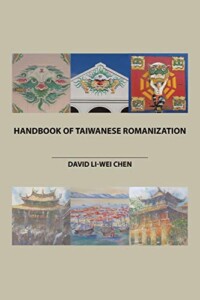Title: Handbook of Taiwanese Romanization
Author: David Li-Wei Chen
Publisher: Xlibris
ISBN: 1543454488
Pages: 224
Genre: Education
Reviewed by: David Allen
Pacific Book Review
This book will be of great interest to Taiwanese people interested in learning their mother tongue through the accessible method of Romanization (more on this below.) Beyond this, Asian-Americans and general reading audiences may find the expert instruction here to be relevant to a greater understanding of the language and its phonetic and lexical counterparts.
Taiwan, a country of 168 islands the main island being Taiwan, or Formosa, has been settled for at least 25,000 years. The country is often in the news because of its fragile and sensitive location near mainland China, and because of its enduring autonomy from Communist China. Taipei is the capital of Taiwan. So much for geography lessons.
Taiwanese and the related Hokkien dialect are among the most widely spoken non-Mandarin Chinese languages overseas. Each Chinese language uses Chinese characters; rules for pronunciation are based on how each character is used. There are some eight to fifty thousand Chinese characters.
Romanization is the conversion of text from a different language or writing system to Roman (Latin) script. Methods of romanization include transliteration (representation of written text), and transcription (representation of the spoken word.) Transcription is either phonemic (recording phonemes – units of semantic meaning in speech) or phonetic (recording speech sounds.) Romanization is a more feasible alternative to written Chinese characters because it preserves the spoken language and colloquialisms that cannot be expressed in written Chinese.
All of this background is relevant and important to David Li-Wei Chen’s Handbook of Taiwanese Romanization, which masterfully sets out a highly accessible and cogent Romanization strategy for learning Taiwanese. This reader-friendly handbook begins with a chapter on how to use the book; subsequent chapters include ‘Taiwanese Phonics and Romanization’; ‘Taiwanese Tones’; and ‘Rules for Taiwanese Romanization’. There are also chapters on Romanization of additional dialects – and much more. Throughout, there is amplification of the material through clear writing in both English and Chinese.
The author explains that “…learning Taiwanese/Hokkien Romanization with knowledge of phonetics and tones is the most feasible way for overseas Taiwanese communities to read and write their mother tongues. Knowledge of traditional Chinese characters is not required but recommended.”
David Li-Wei Chen further notes that additional ways of encouraging literacy through Taiwanese Romanization are with Taiwanese pop music lyrics and Taiwanese proverbs and idioms. This gives a feel for Li-Wei Chen’s broad approach and inclusiveness; he is a teacher, concerned with passing on the living tradition of an important language.
A handbook like David Li-Wei Chen’s is hard to find. It will occupy an important place in the curricula of all those interested in learning Taiwanese.



Follow Us